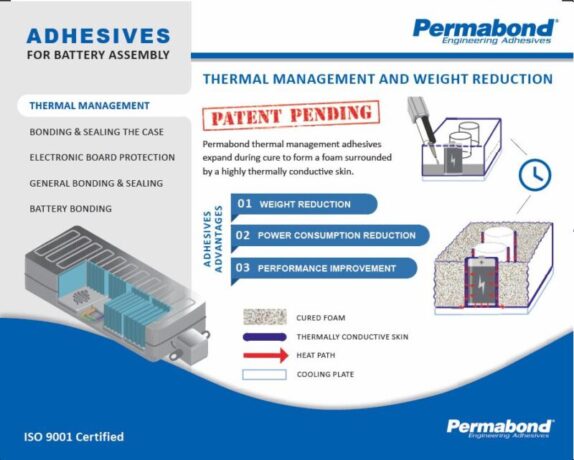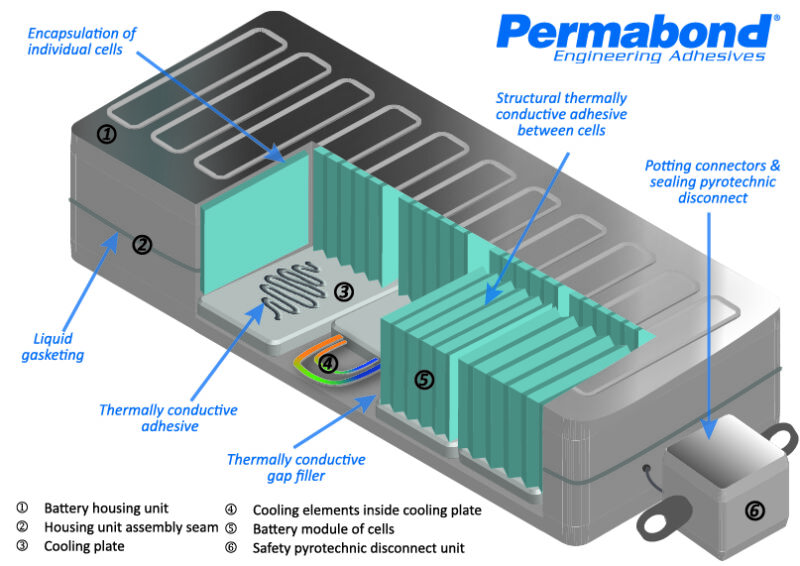The battery bonding market is a rapidly growing hotbed of innovation, with new R&D facilities and giga factories popping up left, right and centre! This is bringing a whole new level of complexity and challenges to the world of engineering adhesives. Development chemists at Permabond have been working hard to satisfy important adhesive features that battery manufacturers need – including some of these key requirements:
- High levels of thermal conductivity to help with thermal management
- Fire retardancy – to prevent fire in the event of accident or short circuit
- Electrically insulating properties (or electrical conductivity in some cases)
- Practical integration into a fast, high volume production line
- Performance improvements
- Cost savings
Permabond has some great products already available for battery applications (including cell bonding, potting/encapsulation and bonding the battery housing), but Permabond’s main strength is the ability to custom-formulate specific adhesives for clients. The custom design process is a very useful service that Permabond offers. Features and requirements can be fully discussed with engineers and adhesive development chemists. Samples are then supplied, trials conducted and testing is carried out to help manufacturers find the most practical and effective adhesive solution for their particular application, while at the same time, helping them to meet production efficiency targets.
Recent innovations include Permabond’s new MT3836 adhesive – a two-component hybrid system. It cures fully at room temperature to form a flexible, thermally conductive/electrically insulating material, suitable for bonding a wide variety of substrate materials.
This product contains a thermally conductive filler which helps transfer heat from component parts, making it a great choice for bonding electric vehicle battery modules. Not only does it help with thermal management but it is also fire retardant to UL94-V0. Its high level of flexibility and compressibility helps minimise stress on sensitive components, absorbing vibration, impact and differential expansion and contraction stresses.
Benefits of this product include:
- Two-part resin and hardener, conveniently applied from cartridges with mixing nozzles
- Full cure at room temperature (handling time 2-3 hours)
- Gap filling to 5mm
- Thermally conductive >1 W/(m.K)
- Fire retardant to UL94-V0
- Elongation >100%, Shore A hardness 60.
Coupled with the exciting launch of Permabond’s new MT3836 thermally conductive hybrid adhesive, Permabond reveals its latest innovation in the world of electric battery bonding: A thermally conductive expanding adhesive! This new technology (patent pending) incorporated into adhesive formulations, allows the adhesive to expand and fill the gaps surrounding battery cells, whilst forming a thermally conductive skin to enhance thermal conductivity, assisting the thermal management of the battery unit.

Thermally conductive materials are typically quite high density and add a lot of weight to batteries, making them heavy and difficult to handle. By using a low-density foam instead, battery weight can be reduced, therefore reducing the vehicle weight and improving the fuel economy and performance as well as increasing the vehicle range between charges.
Why not have a chat with Permabond’s friendly technical engineers, either by phone on +44 (0)1962 711661), webchat on www.permabond.co.uk or email help.europe@permabond.com and see whether we can come up with your perfect battery bonding adhesive!

